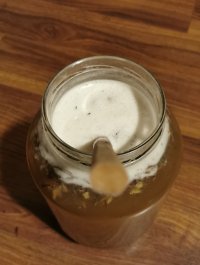So a few weeks ago I accidentally made a very small batch of wild session-ish mead...
I had some spruce tips infusing in a 1 liter jar of water for a few weeks and mixed that with a liter of green tea with tulsi a few drops of lemon juice and some raisins..covered the container with cheesecloth and sure enough I got fermentation! after 3 days this stuff started bubbling and smelling like beer.... but GOOD beer!
my goal was to make a very young low alcoholic viking style mead anyways based on a recipe that said 3 day primary then what was supposed to be a 2 day secondary fermentation then it's supposed to be drinkable like how this guy describes in this video
but I didn't really do that ... so I strained that after day 3 then racked into another jar with a turkey baster (chya I know...but I live in a small town and there's no equipment here for stuff like this) but instead of cold crashing it after the 2 days I just left it in my closet with a sealed lid and burped it every day, (no airlocks here!) had a small glass a night and it tasted stronger over the course of the 8 days it lasted but still pretty good!
I dunno if that was too wise to not cold crash it and pretty much just drink it off the lees but meh..... for only 3 days primary with wild yeast I was impressed
Fast forward to now and I'm trying the same thing with rosemary and sage and it's bubbling pretty good but the smell is quite different than whatever yeast came off the spruce tips .....
it smells well..kinda "farty" ... but regardless it's on the way... I moved it away from the heater and just have it in the closet now but I'm wondering if I leave it longer in the fermenter how it would turn out ... but this smell isn't as pleasant as the last batch with the spruce and I'm a little afraid to do the strain and rack now .. wondering if I leave it longer if the fart smell will eventually go away
but regardless it's on the way... I moved it away from the heater and just have it in the closet now but I'm wondering if I leave it longer in the fermenter how it would turn out ... but this smell isn't as pleasant as the last batch with the spruce and I'm a little afraid to do the strain and rack now .. wondering if I leave it longer if the fart smell will eventually go away
I had some spruce tips infusing in a 1 liter jar of water for a few weeks and mixed that with a liter of green tea with tulsi a few drops of lemon juice and some raisins..covered the container with cheesecloth and sure enough I got fermentation! after 3 days this stuff started bubbling and smelling like beer.... but GOOD beer!
my goal was to make a very young low alcoholic viking style mead anyways based on a recipe that said 3 day primary then what was supposed to be a 2 day secondary fermentation then it's supposed to be drinkable like how this guy describes in this video
but I didn't really do that ... so I strained that after day 3 then racked into another jar with a turkey baster (chya I know...but I live in a small town and there's no equipment here for stuff like this) but instead of cold crashing it after the 2 days I just left it in my closet with a sealed lid and burped it every day, (no airlocks here!) had a small glass a night and it tasted stronger over the course of the 8 days it lasted but still pretty good!
I dunno if that was too wise to not cold crash it and pretty much just drink it off the lees but meh..... for only 3 days primary with wild yeast I was impressed
Fast forward to now and I'm trying the same thing with rosemary and sage and it's bubbling pretty good but the smell is quite different than whatever yeast came off the spruce tips .....
it smells well..kinda "farty" ...
Attachments
Last edited:










































![Craft A Brew - Safale BE-256 Yeast - Fermentis - Belgian Ale Dry Yeast - For Belgian & Strong Ales - Ingredients for Home Brewing - Beer Making Supplies - [3 Pack]](https://m.media-amazon.com/images/I/51bcKEwQmWL._SL500_.jpg)


















